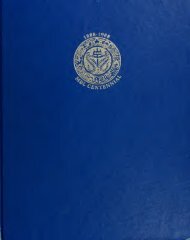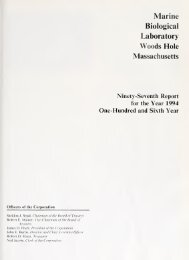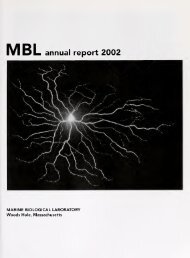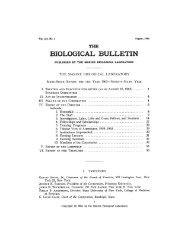24 researchJohn Hobbie Named MBL Distinguished ScientistPublicationsBahr, M; Crump, BC;Klepac-Ceraj, V; Teske,A; Sogin, ML; Hobbie,JE. 2005. Molecularcharacterization ofsulfate-reducing bacteriain a New England saltmarsh. Env. Microbiol.7(8): 1175-1185.Benstead, JP; Deegan,LA; Peterson, BJ; Huryn,AD; Bowden, WB;Suberkropp, K; Buzby,KM; Green, AC; Vacca,JA. 2005. Responses ofa beaded Arctic streamto short-term N and Pfertilisation. FreshwaterBiol. 50(2): 277-290.Bernhard, AE; Donn, T;Giblin, AE; Stahl, DA.2005. Loss of diversityof ammonia-oxidizingbacteria correlates withincreasing salinity inan estuary system. Env.Microbiol. 7: 1289-1297.Boelman, NT; Stieglitz,M; Griffin, KL; Shaver,GR. 2005. Inter-annualvariability of NDVIin response to longtermwarming andfertilization in wet sedgeand tussock tundra.Oecologia 143(4): 588-597.Booth, MS; Stark, JM;Rastetter, EB. 2005.Controls on nitrogencycling in terrestrialecosystems: A syntheticanalysis of literaturedata. Ecol. Monogr. 75:139-157.Cerri, CC; Melillo, JM;Feigl, BJ; Piccolo, MC;Neill, C; Steudler, PA;Carvalho, MS; Godinho,VP; Cerri, CEP; Bernoux,M. 2005. Recent historyof the agriculture ofthe Brazilian AmazonBasin: Prospects forsustainable developmentand a first look atthe biogeochemicalconsequences of pasturereformation. Outlook onAgriculture 34(4):215-223.Chan, ASK; Steudler, PA;Bowden, RD; Gulledge,J; Cavanaugh, CM.2005. Consequences ofnitrogen fertilizationon soil methaneconsumption in aproductive temperatedeciduous forest. Biologyand Fertility of Soils 41(3):182-189.Colinvaux, P. 2005.Coping with interestingtimes. Nature 437(7058):479.Cross, WF; Benstead,JP; Frost, PC; Thomas,SA. 2005. Ecologicalstoichiometry infreshwater benthicsystems: recent progressand perspectives.Freshwater Biol. 50(11):1895-1912.Crump, BC; Hobbie,JE. 2005. Synchronyand seasonality inbacterioplanktoncommunities of twotemperate rivers. Limnol.Oceanogr. 50(6): 1718-1729.Deegan, LA; Buchsbaum,RN. 2005. The effectof habitat loss anddegradation on fisheries.In Buchsbaum, RN;Pederson, J; Robinson,WE, eds. The Declineof Fisheries Resourcesin New England:Evaluating the Impactof Overfishing,Contamination, andHabitat Degradation.MITSG 05-5. MIT SeaGrant College Program.MIT Sea Grant Press,Cambridge, MA.Deegan, L; Golden, H;Harrison, J; Kracko,K. 2005. Swimmingability and metabolismof 0+ Arctic grayling(Thymallus arcticus). J.Fish Biol. 67(4): 910-918.do Carmo, JB; Neill, C;Garcia-Montiel, DC;Piccolo, MD; Cerri, CC;Steudler, PA; de Andrade,CA; Passianoto, CC;Feigl, BJ; Melillo, JM.2005. Nitrogen dynamicsduring till and no-tillpasture restorationsequences in Rondônia,Brazil. Nutrient Cyclingin Agroecosystems 71(3):213-225.Ecosystems Center co-director John Hobbie wasnamed MBL Distinguished Scientist in July 2005.Distinguished Scientist is a special recognitionthat is bestowed on an MBL scientist withoutstanding scientific achievements and serviceto the scientific community. Only one otherMBL scientist, Shinya Inoué, currently holds thisdesignation.Hobbie has sustained an impressive array ofresearch and outreach activities for over 40 years.His research has attempted to identify the factorscontrolling decomposition and productivitywithin aquatic ecosystems. His current researchinterests center on the role of microbes in freshwater, estuarine, and soilecosystems. Field sites for this work are located at the Plum Island estuary onMassachusetts’ North Shore and the Toolik Lake Field Station on the NorthSlope of Alaska. Both are part of the National Science Foundation (NSF)’s 26sites across North America and Antarctica designated as Long-Term EcologicalResearch (LTER) Programs. Hobbie helped establish the Arctic LTER site and isthe director of the Arctic LTER project, which focuses on the ecology of tundra,streams, and lakes at Toolik Lake.Hobbie received a B.A. from Dartmouth College, an M.A. from the <strong>University</strong> ofCalifornia, Berkeley, and a Ph.D. from Indiana <strong>University</strong>. Following a researchassociate position at the <strong>University</strong> of California, Davis, and a postdoctoralfellowship at Uppsala <strong>University</strong> in Sweden, he held a faculty position at NorthCarolina <strong>State</strong> <strong>University</strong> from 1965 to 1976, starting as an assistant professorand eventually advancing into full Professor rank. Hobbie joined the scientificstaff of the MBL’s Ecosystems Center in 1976. He served as director of the centerfrom 1984 to 1989 and now serves as its co-director with Jerry Melillo.In addition to his work at the MBL, Hobbie was president of the AmericanSociety of Limnology and Oceanography from 1984 to 1986, served on theBoard of Directors for the Arctic Research Consortium of the U.S. from 1989 to2001, and served on the U.S. Arctic Research Commission from 1996 to 2004. Heis currently a member of the NSF’s LTER Program’s Executive Committee.The American Society of Limnology and Oceanography recognized Hobbie asan outstanding scientist when he was awarded the society’s Hutchinson Awardfor research for revolutionizing the understanding of the importance of bacteriain natural waters. In 1988, he received the prestigious Tage Erlander VisitingProfessor Award from the Royal Academy of Science, which supported a year oflectures and research throughout Sweden. In 2005, he was awarded the OdumLifetime Achievement Award from the Estuarine Research Federation.Hobbie has published more than 140 research articles and has edited severalbooks. His 1975 paper with Ralph Daley, “Direct Counts of Aquatic Bacteria bya Modified Epifluorescence Technique,” is one of the most cited papers in allof ecology. He is a noted author whose writings cover a wide range of topicsranging from arctic limnology to coastal ocean biogeochemistry and microbialactivity in oceans, lakes, and soils.
esearch 25Drake, DC; Smith,JV; Naiman, RJ. 2005.Salmon decay andnutrient contributionsto riparian forest soils.Northwest Sci. 79(1):61-71.Fagherazzi, S; Torres,R; Hopkinson, C; vanProosdij, D. 2005. Saltmarsh geomorphology:Physical and ecologicaleffects on landform.EOS - AGU Transactions8: 57-58.Felzer, B; Reilly, J;Melillo, J; Kicklighter,D; Sarofim, M; Wang,C; Prinn, R; Zhuang,Q. 2005. Futureeffects of ozone oncarbon sequestrationand climate changepolicy using a globalbiogeochemical model.Climatic Change 73(3):345-373.Frost, PC; Cross, WF;Benstead, JP. 2005.Ecological stoichiometryin freshwater benthicecosystems: Anintroduction. FreshwaterBiol. 50(11): 1781-1785.Goodman, SM; Benstead,JP. 2005. Updatedestimates of bioticdiversity and endemismfor Madagascar. Oryx 39(1): 73-77.Hobbie, SE; Gough,L; Shaver, GR. 2005.Species compositionaldifferences on differentagedglacial landscapesdrive contrastingresponses of tundra tonutrient addition. J. Ecol.93(4): 770-782.Hopkinson, CS Jr;Vallino, JJ. 2005.Efficient export ofcarbon to the deepocean through dissolvedorganic matter. Nature433(7022): 142-145.Huryn, AD; Slavik, KA;Lowe, RL; Parker, SM;Anderson, DS; Peterson,BJ. 2005. Landscapeheterogeneity and thebiodiversity of Arcticstream communities:A habitat templateanalysis. Can. J. Fish.Aquatic Sci. 62(8): 1905-1919.Krusche, AV; Ballester,MVR; Victoria, RL;Bernardes, MC; Hanada,L; Marcondes, R;Victoria, DC; Toledo,AM; Ometto, JP;Moreira, MZ; Toledo,AM; Boloso, MA; Neto,SG; Bonelli, N; Deegan,LA; Neill, C; Thomas,SM; Aufdenkampe,A; Richey, JE. Asmudanças no uso daterra e a biogeoquímicados corpos d’águana Amazônia. ActaAmazonica 35: 197-205.Lajtha, K., Crow, SE;Yano, Y; Kaushal, SS;Sulzman, E; Sollins,P; Spears, JDH. 2005.Detrital controls onsoil solution N anddissolved organicmatter in soils: Afield experiment.Biogeochemistry 76: 261-281.Liu, JY; Tian, HQ;Liu, ML; Zhuang, DF;Melillo, JM; Zhang, ZX.2005. China’s changinglandscape during the1990s: Large-scaleland transformationsestimated with satellitedata. Geophys. Res. Lett.32(2) art. no. L02405.Logan, J; Haas, H;Deegan, L; Gaines, E.2005. Turnover ratesof nitrogen stableisotopes in the saltmarsh mummichog,Fundulus heteroclitus,following a laboratorydiet switch. Oecologia.E-first. 10.1007/s00442-005-0277-z.McGuire, AD; Apps,M; Chapin III, FS;Dargaville, R; Flannigan,MD; Kasischke, ES;Kicklighter, D; Kimball,J; Kurz, W; McRae, DJ;McDonald, K; Melillo,J; Myneni, R; Stocks, BJ;Verbyla, DL; Zhuang,Q. 2005. Canadaand Alaska. Chapter9, pp. 139-161 inLand Change Science:Observing, Monitoring,and UnderstandingTrajectories of Changeon the Earth’s Surface.Dordrecht, Netherlands,Kluwer AcademicPublishers.Melillo, JM; Grimm,NB; Schlesinger,WH. 2005. Ecologyand the transition tosustainability. Frontiersin Ecology and theEnvironment 1(3): 3.Melillo, JM; Grimm,NB; Covich, A. 2005.NEON: lighting theway forward. Frontiersin Ecology and theEnvironment 7(3): 351.Meyerson, LA; Baron,J; Melillo, JM; Naiman,RJ; O’Malley, RI;Orians, G; Palmer, MA;Pfaff, ASP; Running,SW; Sala, OE. 2005.Aggregate measuresof ecosystem services:Can we take the pulseof nature? Frontiersin Ecology and theEnvironment 3(1): 56-59.Miller, G. H.,Mangan, J., Pollard,D., Thompson, S. L.,Felzer, B. S. and J. W.Magee. Sensitivityof the Australianmonsoon to insolationand vegetation:implications for humanimpact on continentalmoisture balance.Geology 33(1): 65-68.Morgan, MG; Cantor,R; Clark, WC; Fisher,A; Jacoby, HD; Janetos,AC; Kinzig, AP;Melillo, J; Street, RB;Wilbanks, TJ. 2005.Learning from the USNational Assessment ofClimate Change impacts.Environmental Science& Technology 39(23):9023-9032.Neill, C; Steudler, PA;Garcia-Montiel, DC;Melillo, JM; Feigl, BJ;Piccolo, MC; Cerri,CC. 2005. Rates andcontrols of nitrousoxide and nitric oxideemissions followingconversion of forest topasture in Rondônia.Nutrient Cycling inAgroecosystems 71(1):1-15.O’Brien, WJ; Barfield,M; Bettez, N; Hershey,AE; Hobbie, JE; Kipphut,G; Kling, G; Miller,MC. 2005. Long-termresponse and recoveryto nutrient addition of apartitioned Arctic lake.Freshwater Biol. 50(5):731-741.Pan, YD; Luo, TX;Birdsey, R; Hom,J; Melillo, J. 2005.New estimates ofcarbon storage andsequestration in China’sforests: Effects ofage–class and method oninventory-based carbonestimation. ClimaticChange 67(2-3): 211-236.Peterson, BJ. 2005.Abrupt climate change:Ocean salinity changesand the potentialimpacts on oceancirculation. Pp. 80-84 inHarrison, P, ed. Geo YearBook: An Overview of OurChanging Environment2004/5. UnitedNations EnvironmentalProgramme (UNEP),Nairobi.Rastetter, EB; Perakis,SS; Shaver, GR; Agren,GI. 2005. TerrestrialC sequestration atelevated-CO 2andtemperature: The role ofdissolved organic N loss.Ecological Applications15(1): 71-86.Rastetter, EB;Kwiatkowski, BL;McKane, RB. 2005. Astable isotope simulatorthat can be coupled toexisting mass balancemodels. EcologicalApplications 15(5): 1772-1782.Roberts, BJ; Howarth,RW. 2005. Nutrient andlight availability regulatethe relative contributionof autotrophs andheterotrophs torespiration in freshwaterpelagic ecosystems.Limnol. Oceanogr. 51:288-295.Vallino, JJ; Hopkinson,CS; Garritt, RH. 2005.Estimating estuarinegross production,community respirationand net ecosystemproduction: A nonlinearinverse technique.Ecological Modeling 187:281-296.van Wijk, MT;Williams, M. 2005.Optical instrumentsfor measuring leaf areaindex in low vegetation:Application in Arcticecosystems. EcologicalApplications 15(4): 1462-1470.van Wijk, MT; Williams,M; Shaver, GR.2005. Tight couplingbetween leaf areaindex and foliage Ncontent in arctic plantcommunities. Oecologia142(3): 421-427.Wan, Z; Vallino, JJ.2005. An inverseecosystem model ofyear-to-year variationswith first orderapproximation to theannual mean fluxes.Ecological Modeling187(4): 369-388.Wilcox, HS; Wallace, JB;Meyer, JL; Benstead, JP.2005. Effects of labilecarbon addition on aheadwater stream foodweb. Limnol. Oceanogr.50(4): 1300-1312.Williams, M;Hopkinson, C; Rastetter,E; Vallino, J; Claessens,L. 2005. Relationshipsof land use and streamsolute concentrationsin the Ipswich Riverbasin, northeasternMassachusetts. Water,Air, and Soil Pollution161(1-4): 55-74.Wollheim, W; Pellerin,B; Vörösmarty, C;Hopkinson, C. 2005. Nretention in urbanizingheadwater catchments.Ecosystems 8(8): 871-884.Yano, Y; Lajtha, K;Sollins, P; Caldwell, BA.2005. Chemistry anddynamics of dissolvedorganic matter in atemperate coniferousforest on andic soils:Effects of litter quality.Ecosystems 8: 286-300.
- Page 1 and 2: MBL7 MBL StreetNon-profit Org.U.S.
- Page 5: contents1 report of the director an
- Page 8 and 9: 2 report of the director and ceoTha
- Page 10 and 11: 4 program profiles“Our lives are
- Page 12 and 13: 6 program profilesoffering unmatche
- Page 14 and 15: 8 program profilestraining pre and
- Page 16 and 17: 10 program profilesforging powerful
- Page 18 and 19: 12 program profilesengaging undergr
- Page 20 and 21: 14 program profilesexciting k-12 te
- Page 22 and 23: 16 researchresearchThe MBL is one o
- Page 24 and 25: 18 researchgenomes. The National Ae
- Page 26 and 27: 20 researchPublicationsAmaral Zettl
- Page 28 and 29: 22 researchThe High Cost of Coastal
- Page 32 and 33: 26 researchwhitman centerThe Whitma
- Page 34 and 35: 28 researchA New Twist on Power Wal
- Page 36 and 37: 30 researchfellowshipsMBL Research
- Page 38 and 39: 32 researchAlbert and Ellen Grass F
- Page 40 and 41: 34 researchFriday Evening Lecture S
- Page 42 and 43: 36 researcharchitectural dynamics i
- Page 44 and 45: 38 researchBUMP staff, cont.PH.D. S
- Page 46 and 47: 40 researchmarine resources program
- Page 48 and 49: 42 researchMarine Resources Program
- Page 50 and 51: 44 researchprogram in molecular phy
- Page 52 and 53: 46 researchlaboratory of aquatic bi
- Page 54 and 55: 48 researchlaboratory of norman wai
- Page 56 and 57: 50 educationsummer coursesBiology o
- Page 58 and 59: 52 educationGreenberg, Everett, Uni
- Page 60 and 61: 54 educationMaul, Kristen, City Col
- Page 62 and 63: 56 educationPata, Veena, National I
- Page 64 and 65: 58 educationspecial topics coursesA
- Page 66 and 67: 60 educationMaiato, Helder, Institu
- Page 68 and 69: 62 educationBrower, Stewart, Univer
- Page 70 and 71: 64 educationFACULTYCurran, Sean, Ma
- Page 72 and 73: 66 educationGeunes-Boyer, Scarlett,
- Page 74 and 75: 68 educationSTUDENTSAparicio, Paul,
- Page 76 and 77: 70 educationother educational progr
- Page 78 and 79: 72 educationscholarship awardsIn 20
- Page 80 and 81:
74 educationCaswell Grave Scholarsh
- Page 82 and 83:
76 educationMilton L. Shifman Endow
- Page 84 and 85:
78 mblwhoi librarytrends, and curre
- Page 86 and 87:
80 financialsfinancialsreport of th
- Page 88 and 89:
82 financialsOperating History and
- Page 90 and 91:
84 giftsWe are grateful as well to
- Page 92 and 93:
86 giftsRestricted gifts(up to $9,9
- Page 94 and 95:
88 giftsMEMBER($1,000 - $2,499)Edwa
- Page 96 and 97:
90 giftsJohn E. Hobbie Fund for Sci
- Page 98 and 99:
92 giftsMr. and Mrs. J. Sterling Cr
- Page 100 and 101:
94 giftsLectureshipsJohn J. Cebra L
- Page 102 and 103:
96 gifts10th AnniversaryDr. Eva M.
- Page 104 and 105:
98 giftsMBL AssociatesThe Associate
- Page 106 and 107:
100 giftsMr. James K. TaylorMrs. Al
- Page 108 and 109:
102 giftsMBL Golf OutingIn July, MB
- Page 110 and 111:
104 giftsFellowships Established in
- Page 112 and 113:
106 giftsSemester in Environmental
- Page 114 and 115:
108 governance & administrationgove
- Page 116 and 117:
110 governance & administrationcorp
- Page 118 and 119:
112 governance & administrationDr.
- Page 120 and 121:
114 governance & administrationcoun
- Page 122 and 123:
116 governance & administrationadmi
- Page 124:
118 governance & administrationPhot
















